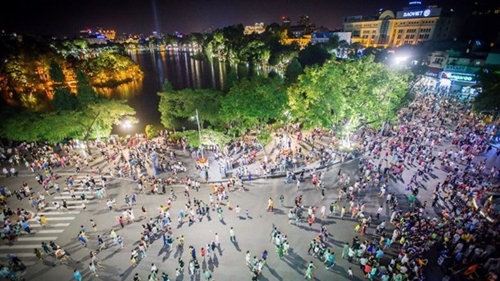The VFCD 2022, the fourth edition of its kind, is organised by RMIT University Vietnam in collaboration with UNESCO, Vietnam National Institute of Culture and Arts Studies (VICAS), COLAB Vietnam and other partners in the creative industries.
The program will include cultural exploration tours, talks, seminars, workshops, exhibitions, and various online activities discussing the visions, trends, cultural identity and future opportunities for creative industries in Vietnam. Most events will not require entrance fees.
“We have seen massive global shifts created by the COVID-19 pandemic,” said Professor Julia Gaimster, dean of RMIT School of Communication & Design.
    |
 |
|
Pedestrian street around Hoan Kiem lake chosen to host several activities of Vietnam Festival of Creativity & Design 2022 |
“These include the ways in which people work, how they connect and communicate, and their priorities for the future. Our aim is to make the festival sustainable for the future, to continue to create impact and support for the creative industries in Vietnam, and to provide opportunities for a wider audience to engage with and understand the value of creativity in all aspects of our lives,” Julia said.
In anticipation of the main program in November, this year’s festival has opened up an unprecedented opportunity for cross-disciplinary collaboration with the Creativity Challenge Playground.
Currently underway, this challenge pairs individuals, groups, organizations or businesses operating in at least two different creative fields.
Each pair will receive funding of 50 million VND (2,100 USD) and support from the organizers to generate ideas and produce prototypes of cultural and creative products or services.
These prototypes will be showcased during the festival weeks in Hanoi and Ho Chi Minh City.
“The Creative Challenge Playground is essentially a model that promotes interdisciplinary connectivity in creative practice,” said Associate Professor, Dr. Nguyen Thi Thu Phuong, deputy director of the VICAS.
“It forms ideas that embody ‘change for sustainable development’ – the theme of the challenge. We expect to create a playground to connect, challenge and get Vietnamese talent to go beyond their creative capacity. They can level up their knowledge and skills relating to culture, arts and creativity, while building their capacity for cross-disciplinary project execution and management.”
VFCD, initiated by RMIT University Vietnam in 2019, creates an open, timely and interactive platform for creative individuals and organisations to engage with an extended audience online and offline.
It has contributed to driving partnerships and projects among organizations and individuals in the cultural-creative sector in Vietnam over the past three years.
The festival organization board is calling on the creative and cultural communities in Vietnam to submit proposals for events and activities to be featured in the festival this year.
Individuals, groups, organizations and enterprises are welcomed to propose their ideas by 15th September 2022 via the registration form.
By organizing a series of creative activities that are open to all, VFCD is a catalyst to realize objectives of the National Strategy for the Development of Cultural Industries in Vietnam.
At the same time, the festival supports the formation of a “creative belt” across the country through the eventual expansion of the UNESCO Creative Cities Network in Vietnam.
Hanoi was designated as part of the network on October 30, 2019, according to the municipal Department of Culture and Sports.
UNESCO launched the Creative Cities Network in 2004 to promote cooperation among cities that recognize creativity as a significant factor in their development.
The network recognizes seven factors - craft and folk arts, media, film, design, gastronomy, literature, and music - as creative fields.
The capital city of Hanoi has a development history of over 1,000 years, and has been in the process of reform and integration, taking creativity and innovative economy as the core in its dynamic, comprehensive and sustainable development.
Source: VNA